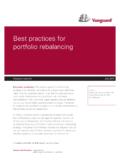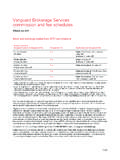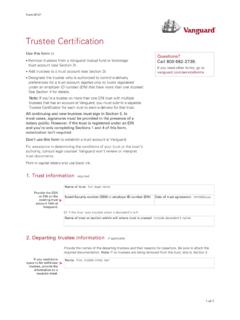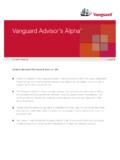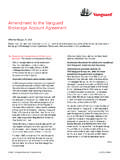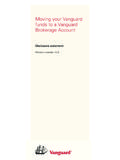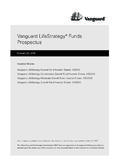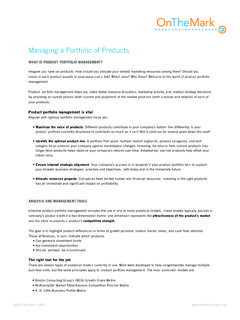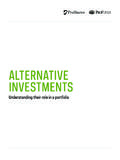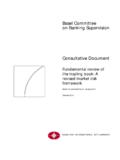Transcription of Best practices for portfolio rebalancing - Vanguard
1 The Bestbuck stopsfor practices here: Vanguard money market funds portfolio rebalancing Vanguard Research November 2015. Yan Zilbering; Colleen M. Jaconetti, CPA, CFP ; Francis M. Kinniry Jr., CFA. The primary goal of a rebalancing strategy is to minimize risk relative to a target asset allocation, rather than to maximize returns. Over time, asset classes produce different returns that can change the portfolio 's asset allocation. To recapture the portfolio 's original risk-and-return characteristics, the portfolio should therefore be rebalanced. In theory, investors select a rebalancing strategy that weighs their willingness to assume risk against expected returns net of the cost of rebalancing . Vanguard research has found that there is no optimal frequency or threshold for rebalancing , since risk-adjusted returns do not differ meaningfully from one rebalancing strategy to another. As a result, we conclude that for most broadly diversified stock and bond fund portfolios (assuming reasonable expectations regarding return patterns, average returns, and risk), annual or semiannual monitoring, with rebalancing at 5% thresholds, is likely to produce a reasonable balance between risk control and cost minimization for most investors.
2 Annual rebalancing is likely to be preferred when taxes or substantial time/costs are involved. Return data for Figures 2, 3, 5, 6, and 8 of this paper are based on the following stock and bond benchmarks, as applicable: Stocks are represented by the Standard & Poor's 90 from 1926 through March 3, 1957; the S&P 500 Index from March 4, 1957, through 1969; the MSCI World Index from 1970 through 1987; the MSCI All Country (AC) World Index from 1988 through May 31, 1994; and the MSCI AC World IMI Index from June 1, 1994, through 2014. Bonds are represented by the S&P High Grade Corporate Index from 1926 through 1968; the Citigroup High Grade Index from 1969 through 1972; the Lehman Long-Term AA Corporate Index from 1973 through 1975; the Barclays Aggregate Bond Index from 1976 through 1989; and the Barclays Global Aggregate Bond Index (USD hedged) from 1990 through 2014. Except as noted, the portfolios are weighted 50% stocks/50% bonds. Notes on asset-return distributions and risk The asset-return distributions shown here represent Vanguard 's view on the potential range of risk premiums that may occur over the next ten years; such long-term projections are not intended to be extrapolated into a short-term view.
3 These potential outcomes for long-term investment returns are generated by the Vanguard Capital Markets Model . (VCMM see the description in Appendix I) and reflect the collective perspective of our Investment Strategy Group. The expected risk premiums and the uncertainty surrounding those expectations are among a number of qualitative and quantitative inputs used in Vanguard 's investment methodology and portfolio -construction process. All investing is subject to risk, including the possible loss of the money you invest. Diversification does not ensure a profit or protect against a loss in a declining market . There is no guarantee that any particular asset allocation or mix of funds will meet your investment objectives or provide you with a given level of income. 2. Vanguard believes that the asset allocation decision Costs of rebalancing which takes into account each investor's risk tolerance, Throughout this paper, the term costs of rebalancing time horizon, and financial goals is the most important refers to: decision in the portfolio -construction process.
4 This is because asset allocation is the major determinant of risk Taxes (if applicable): If rebalancing within taxable and return for a given Over time, however, as registrations, capital gains taxes may be due upon a portfolio 's investments produce different returns, the the sale if the asset sold has appreciated in value. portfolio will likely drift from its target asset allocation, Transaction costs to execute and process the acquiring risk-and-return characteristics that may be trades: For individual securities and exchange-traded inconsistent with an investor's goals and preferences. funds (ETFs), the costs are likely to include brokerage By periodically rebalancing , investors can diminish commissions and bid-ask For mutual funds, the tendency for portfolio drift, and thus potentially costs may include purchase or redemption fees. reduce their exposure to risk relative to their target asset allocation. Time and labor costs to compute the rebalancing amount: These costs are incurred either by the As part of the portfolio -construction process, it's investor directly or by a professional investment important for investors to develop a rebalancing strategy manager.
5 The costs may include administrative that formally addresses how often, how far, and how costs and management fees, if a professional much : that is, how frequently the portfolio should be manager is hired. monitored; how far an asset allocation can be allowed to deviate from its target before it is rebalanced; and Keep in mind that in addition to these costs, there whether periodic rebalancing should restore a portfolio may be trading restrictions that could limit the frequency to its target or to a close approximation of the target. of transacting on the accounts. Finally, since there is Although each of these decisions has an impact on a little difference in the results between the frequencies portfolio 's risk-and-return characteristics, the differences analyzed, these costs should be considered when in risk-adjusted returns among the strategies are not very selecting a rebalancing strategy. significant. Thus, the how often, how far, and how much are mostly questions of investor preference.
6 The only clear advantage for any of these strategies, so far as maintaining a portfolio 's risk-and-return characteristics, and without factoring in rebalancing costs, is that a rebalanced portfolio more closely aligns with the characteristics of the target asset allocation than a portfolio that is never rebalanced. 1 See Brinson, Hood, and Beebower (1986); Brinson, Singer, and Beebower (1991); Ibbotson and Kaplan (2000); Davis, Kinniry, and Sheay (2007), and Wallick et al. (2012). 2 The bid-ask spread is the difference between the highest price a buyer is willing to pay for an asset and the lowest price a seller is willing to accept for it. 3. For many investors, rebalancing can be difficult to 38% and then increased again to 56%, in line with rebalancing can be an emotional decision for many the equity market 's performance during the period). investors. After a prolonged period of the equity bull This suggests that investors in aggregate may not market , with global equities up nearly 200% since March rebalance, since rebalancing would have shown a 9, 2009 (according to Morningstar, Inc.
7 , as of December relatively more stable asset mix for the entire period. 31, 2014), rebalancing may seem counterintuitive: It involves selling the outperforming assets (stocks) and Benefit of rebalancing reallocating to the lagging ones (bonds). This may seem especially trying to some investors, given the current low Many investors spend substantial time defining their interest rates on bonds and their low expected returns investment goals and selecting an asset allocation to in the near future. The situation is typical in periods of help them achieve those goals, while also being mindful prolonged one-directional markets, and was also the case of their tolerance for risk. To be successful, however, when Vanguard first published the original research for they must be able to stick with their plan in all kinds of this paper in 2010, shortly after the global equity markets markets. Due to the equity risk premium, over long time lost nearly 60%. In fact, when looking at total assets horizons, the equity portion of the portfolio will likely grow under management in the mutual fund industry globally faster than the bond portion, exposing a larger portion from 2006 through 2014, there is some evidence that of the portfolio to potential equity market corrections.
8 Investors may not readily embrace rebalancing . Figure 1 These corrections can lead investors to abandon their shows that the number of assets under management investment plan, possibly jeopardizing their chances of during those years for equity, fixed income, and money meeting their financial goals. By rebalancing the portfolio market funds tended to drift based on market performance and bringing the risk level back to an acceptable level, (for example, the equity allocation declined from 62% investors are more likely to stick to their plan, endure Figure 1. Global assets under management in open-end mutual funds and ETFs: 2006 through 2014. 175 100%. Asset allocation (% of AUM). Global equity performance 150. 80. 125. (indexed to 100). 100 60. 75 62% equity allocation 56% equity allocation 40. on 12/31/2006 on 12/31/2014. 50. 38% equity allocation 20. 25 at lowest point in period 0 0. 2006 2008 2010 2012 2014. Equities (right). Fixed income (right). Money markets (right).)
9 MSCI AC World IMI (left). Notes: Global equity performance represented by MSCI AC World IMI, year-end 2006 through year-end 2014. AUM = assets under management. Sources: Vanguard , based on data from Morningstar, Inc. Past performance is no guarantee of future returns. 4. market downturns, and be in a better position to meet investors select an asset allocation based on the level their long-term financial goals within their investment of risk they are willing to bear, those who choose to time horizon. include bonds must also accept the fact that they will likely receive a lower return on their portfolio over the Given the equity risk premium, it's important to keep in long term, compared with an all-equity portfolio . mind that the primary benefit of portfolio rebalancing is to maintain the risk profile of an investment portfolio Similar to the selection of a portfolio 's target asset over time, rather than maximize returns. In fact, if a allocation, a rebalancing strategy involves a trade-off given investor's portfolio can potentially hold either stocks between risk and return.
10 As we discussed, the more risk or bonds, and the sole objective is to maximize return an investor is willing to assume, the higher the expected regardless of risk, then that investor should select a 100% return over the long term (the equity risk premium). If a equity Equities have historically outperformed portfolio is never rebalanced, it tends to gradually drift bonds over long time horizons; the trade-off is increased from its target asset allocation as the weight of higher- volatility. Figure 2 shows the historical return distributions return, higher-risk assets increases. Compared with the for various balanced portfolios, moving from 100% bonds target allocation, the portfolio 's expected return increases, on the left-hand side of the figure to an all-stock portfolio as does its vulnerability to deviations from the return on the right, in 10% increments. As expected, Figure 2 of the target asset allocation. bears out that portfolios with larger allocations to equities have a much wider variability of annual returns (both To illustrate this, we compared two hypothetical positive and negative) as well as higher average annualized portfolios, each with a target asset allocation of 50%.
